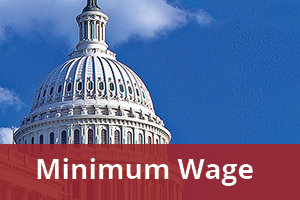President Biden Issues Executive Order Requiring $15 Minimum Wage for Federal Contractors
 Editor’s Note: Explore the side-by-side comparison of minimum wage EOs from 2014 and 2021. This comparison illuminates the differences between the Obama administration’s executive order and the one issued in April by the Biden administration.
Editor’s Note: Explore the side-by-side comparison of minimum wage EOs from 2014 and 2021. This comparison illuminates the differences between the Obama administration’s executive order and the one issued in April by the Biden administration.
On April 27, 2021, President Biden issued an Executive Order (EO) increasing the minimum wage federal contractors pay from $10.95 an hour to $15 an hour. According to a White House fact sheet, starting January 30, 2022, all agencies will need to include a $15 minimum wage in new contract solicitations, and by March 30, 2022, all agencies will need to implement it into new contracts. Furthermore, the higher minimum wage will need to be implemented into existing contracts when extended or renewed.
According to Section 8, the EO applies to:
- Procurement contracts for services or construction;
- Contracts for services covered by the Service Contract Act;
- Contracts for concessions; and
- Contracts “entered into with the Federal Government in connection with Federal property or lands and related to offering services for Federal employees, their dependents, or the general public.”
However, it shall not apply to “grants; contracts, contract-like instruments, or agreements with Indian Tribes under the Indian Self-Determination and Education Assistance Act (Public Law 93-638), as amended; or any contracts or contract-like instruments expressly excluded by the regulations.”
The EO will index the minimum wage to the Consumer Price Index for Urban Wage Earners and Clerical Workers, eliminate the tipped minimum wage for federal contractors by 2024, and extend the required $15 minimum wage to federal contract workers with disabilities. Citing studies covering both an economic impact lens as well as a living wage lens, the White House states that “the Executive Order ensures that hundreds of thousands of workers no longer have to work full-time and still live in poverty.”
Last month, CUPA-HR’s president and CEO, Andy Brantley, discussed these lenses as well as the higher education lens in a research report entitled “How Will Minimum Wage Changes Impact Higher Ed?”. Be sure to review the report for tips on next steps institutions can take, as well as a broader overview of where higher ed is on the $15-an-hour pay scale.
What’s Next?
The EO tasks the secretary of labor with issuing regulations to implement the requirements of the EO by November 24, 2021, and gives the Federal Acquisition Regulatory Council (FAR) 60 days following the issuance of the regulations to include the new wage in federal procurement solicitations. These regulations will need to go through notice-and-comment rulemaking, which will allow impacted stakeholders an opportunity to seek additional clarification on any outstanding questions. CUPA-HR will continue to follow these developments and will ensure higher ed HR’s viewpoints are taken into account during the drafting stage.


